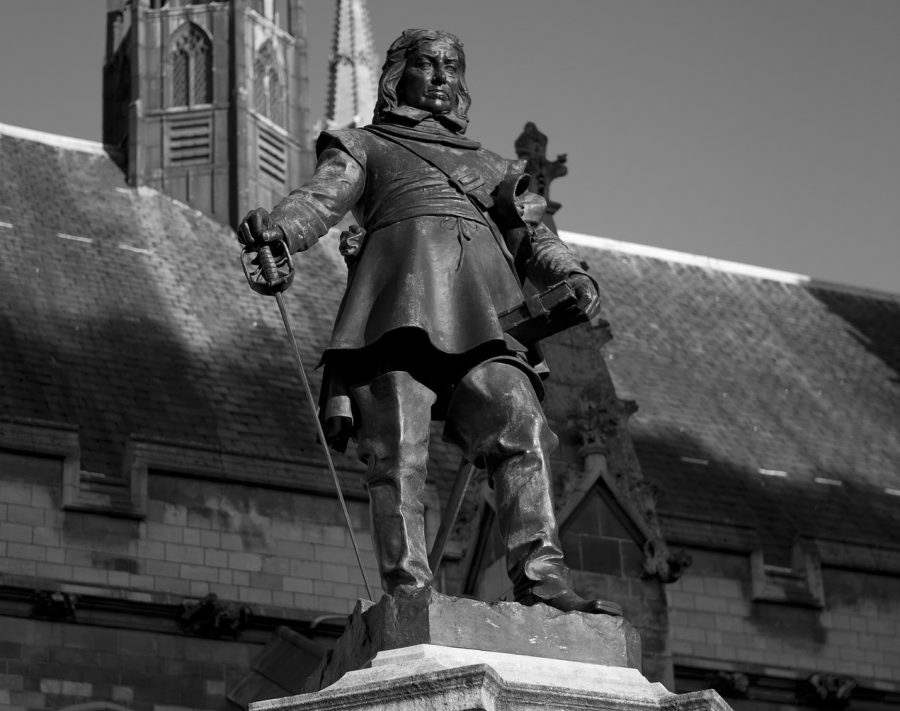Outside Westminster Hall stands a prominent statue of Oliver Cromwell, which was designed by the Victorian sculptor Hamo Thornycroft and erected in 1899 to mark the three hundredth anniversary of the Lord Protector’s birth. In recent days, the question of whether this statue should remain there has again been in the news. I say ‘again’ because the statue has been highly contentious throughout its history. With its fate once more in the headlines, it is worth thinking back to the 1890s and the intense feelings that the statue aroused from the very moment that it was proposed.
Cromwell has been a divisive figure ever since his own lifetime, and this was certainly true in Victorian England. To Gladstonian Liberals, he was a heroic figure and a champion of Parliaments against the tyranny of Charles I. For Tories, on the other hand, he was a regicide and a military dictator who trampled on the nation’s liberties. On this issue, if not on many others, the Tories were able to make common cause with most of the Irish members at Westminster who detested ‘the curse of Cromwell’, especially because of the notorious massacres at Drogheda and Wexford.
No wonder, then, that when the Liberal Prime Minister Lord Rosebery proposed early in 1895 that a statue of Cromwell be erected outside the Palace of Westminster to commemorate the approaching tercentenary of his birth, the suggestion sparked immediate controversy. Most Liberals were supportive, and one described Cromwell as ‘one of the greatest, finest and noblest English rulers that they had ever had in this country’. By contrast, Arthur Balfour spoke for many Tories when he said that Cromwell was ‘not honourably connected with parliamentary government’, and was indeed ‘the only man who absolutely succeeded in uprooting our whole parliamentary government’. After heated debates, the House of Commons voted by 220 to 83 not to grant any public money towards the project: this proved to be the final straw for Rosebery’s ailing government and he resigned a few days later.
Rosebery nevertheless decided to press ahead as a private individual. He commissioned Hamo Thornycroft, one of the leading sculptors of the day, to design a statue of Cromwell, and then contributed £3,000 as an ‘anonymous donor’ to have it made. Thornycroft eagerly accepted the commission: he was already an admirer of Cromwell and had named his first son Oliver after him. As work progressed, Rosebery took a very close interest and regularly sent Thornycroft specific suggestions, such as this: ‘make him rougher, the Bible and sword are right, but make him more militant. He had to do terrible things and this would have affected his appearance’. Rosebery remained convinced that Cromwell was ‘a great soldier, a great ruler, and a great raiser and maintainer of British influence and power abroad’.
The statue nevertheless continued to be dogged by controversy as it neared completion. In The Timesone correspondent asked ‘why not a statue of Guy Fawkes, who doubtless has his admirers?’, while some members of the Commons condemned ‘the Cromwellian manner in which it was erected’. The Irish MP William Redmond, who came from Wexford, wondered ‘whether there is any precedent for granting a site in the vicinity of this House for the erection of a statue to a murderer’. The House of Lords was similarly divided. The Earl of Wemyss felt that Cromwell was ‘one of the greatest men England has ever produced, and that we ought to have a Cromwell statue’. The Earl of Hardwicke, on the other hand, said that he would have preferred ‘a statue of one who typifies the union of the Crown, Constitution, and Church, rather than the statue of a military dictator, who, so far as I know, is chiefly remembered as the destroyer of all three’. He was echoed by Viscount Sidmouth who argued that ‘a site more utterly unfitted for a statue of Oliver Cromwell could not have been selected, as it is within view of Westminster Abbey, which he desecrated, and within the precincts of the Houses of Parliament, which he was an instrument to destroy’. Eventually, the statue was unveiled on 14 November 1899, but at 7.30 in the morning – a time deliberately chosen to try to avoid hostile demonstrations.
The controversy has continued ever since, and has even been the subject of satire. In 1906, the cartoonist Francis Gould published a cartoon in the Liberal newspaper The Westminster Gazette. The cartoon depicts the statue of Cromwell looking down to the lion couchant which sits on the pedestal. Cromwell is saying: ‘I say, they’re talking about pulling us down. What do you think?’ To which the lion is shown replying: ‘They had better not try – there’ll be a row if they do.’
More recently, and more seriously, the statue became a target during the Irish Troubles of the later twentieth century. In June 1974, the Provisional IRA bombed Westminster Hall, and soon afterwards Cromwell’s statue was moved to a safer location. The following March, in response to a question about when Cromwell’s statue would be returned to its customary position, the Labour Secretary of State for the Environment Anthony Crosland indicated that it would be by early 1977, adding that ‘Oliver Cromwell was a stern defender of our constitutional liberties’.
And so to the present. Each year, on 3 September, the date of Cromwell’s death in 1658, members of the Cromwell Association gather at the foot of the statue to hold a commemoration and lay a wreath. Most years, small numbers of protesters gather nearby and make a silent, dignified and peaceful point: some unfurl the flag of the Irish Republic, while others wave the standard of the British monarchy. This scene neatly epitomises the deeply conflicting feelings that Cromwell still inspires, and no doubt the controversy surrounding him and his statue will continue. It has been so for many decades, and that reflects both the divisive nature of Oliver Cromwell as an individual and the contested nature of Britain’s historical past.







